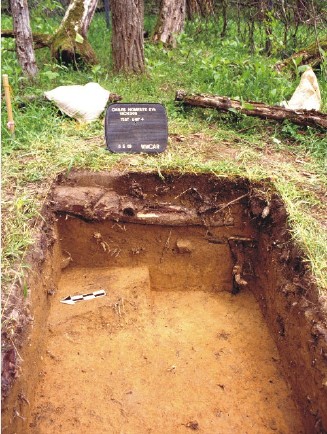Interpretations
Archaeology, along with architectural and documentary evidence, helps build our understanding of the site.
While there is substantial historical and architectural documentation of the Chiles Homesite, archaeological investigations conducted during 2005 also contributed much to our understanding of the site. Through the excavation of the shovel tests, we now have a record of where the artifacts are clustered most densely. These "concentrations" guided by the placement of four test units where we could get a broader look at the traces of past human activity.
 Test Unit 4, placed just to the west of the house revealed a structural post-hole. This feature may represent a portion of a structure which, at one time, served as an outbuilding for the farmstead. The artifacts consistently dated to the 19th century period of occupation and the location here for an outbuilding is likely since the architectural historian Rivoire suggested there might be a smokehouse or dairy just to the west of the house.
Test Unit 4, placed just to the west of the house revealed a structural post-hole. This feature may represent a portion of a structure which, at one time, served as an outbuilding for the farmstead. The artifacts consistently dated to the 19th century period of occupation and the location here for an outbuilding is likely since the architectural historian Rivoire suggested there might be a smokehouse or dairy just to the west of the house.
While it cannot be said with certainty what this outbuilding was, we can limit its functions to a few things. First, the suggestion of a smokehouse or dairy is consistent with other 19th-century farmsteads in the region. Dairies and smokehouses were often small buildings, roughly square in plan, which served to preserve food. A dairy would have been a well-ventilated building kept dark and often with a built-in spring-box or other water supply to help cool the food kept inside. Smokehouses were tightly built buildings where hams, and sometimes fish, were hung to be cured. A smoldering fire would be kept to fully cure the spiced meats as well as keep flies away. After the curing process was complete, the meat would be stored in the smokehouse until it was consumed.
Another possible use for this structure was as housing. Since we know that Reverend Chiles had 14 enslaved African Americans, the farmstead likely included slave cabins. The artifacts recovered from Test Unit 4 exhibit strong evidence of living-quarters. Clay pipe fragments, many household tableware fragments, pieces of window pane glass, buttons, brick, glass bottle fragments, and other household refuse littered the soil within this test unit. Overall, this area seems to contain the highest density of household items outside of the main structure. While there may be other locations for slave dwellings, this area is a likely candidate for the location of such cabins.
The archaeological survey of the Chiles Homesite revealed much about the historic landscape of Douglas Point. Documentary, architectural, and ethnohistoric (interview) evidence was brought together with archaeology to provide a broader understanding of a 19th century family, their laborers, and their neighbors.
Artifacts
Ceramics
The ceramics from the site represent a common assemblage of household hollowares and tablewares. Hollowares are typically bowls, cups, dishes, and other containers whereas tablewares tend to be plates, saucers, and other relatively flat ceramics. The stoneware jug, from which example b came, were ubiquitous throughout American homes. These earthenwares were made in various places throughout the east coast throughout the 19th century.
Examples e and f are also commonly found items on 19th century sites. Manufacture dates for this ceramic type span roughly 1780-1840. These two sherds are from serving plates.
Coarse earthenware, such as with example a, is also a ubiquitous ceramic type with dozens of local kilns producing this type throughout the 18th and into the 19th century. Cheap and easily accessible, coarse earthenwares typically are associated with lesser status and/or come from areas of sites where functional duties are performed such as kitchens, dairies, etc.
Examples c and d typify a moderate amount of status associated with this ceramic group. The handpainted pearlware cup or mug (d) and the colorful pearlware container both would have cost considerably more than a cruder duplicate made from a less-refined earthenware.
 Fossilized shark teeth
Fossilized shark teeth
These Paleocene Epoch (approximately 56 to 58 million years ago) fossilized shark teeth are common throughout the Douglas Point area. Typically they are found in the exposed fossil beds along local riverbanks. A member of the Chiles household may have collected the teeth.
 Skip to main content
Skip to main content
